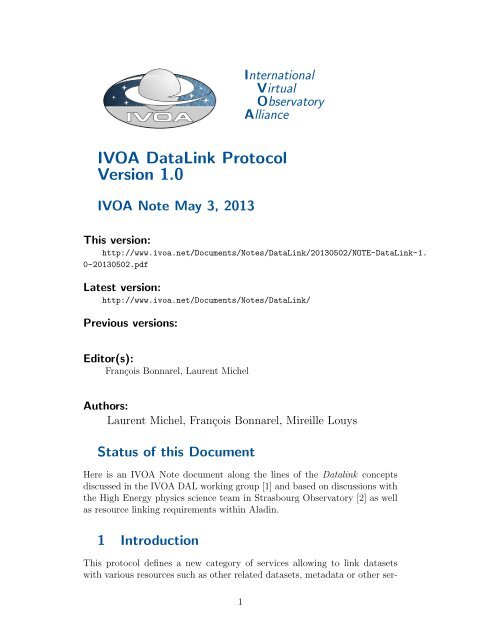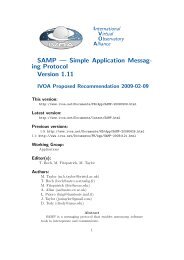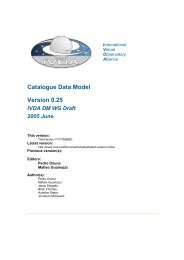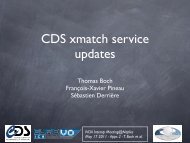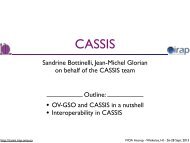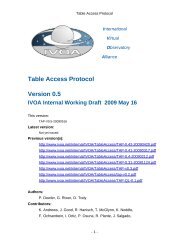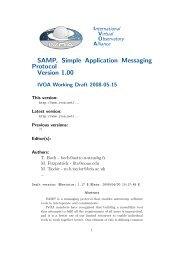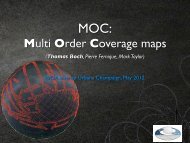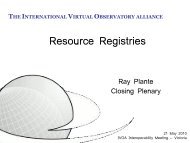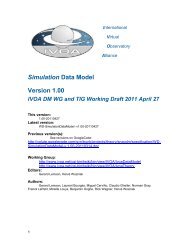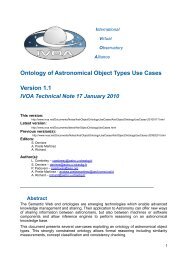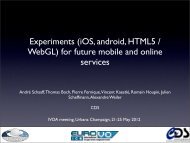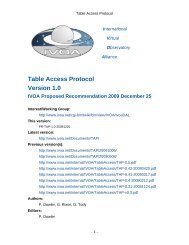IVOA DataLink Protocol Version 1.0
IVOA DataLink Protocol Version 1.0
IVOA DataLink Protocol Version 1.0
Create successful ePaper yourself
Turn your PDF publications into a flip-book with our unique Google optimized e-Paper software.
vices. Its specifity is to provide a binding mechanism and metadata structurenecessary to describe connected datasets or secondary data for independantdatasets discovered in previous VO operations. Data product linking is exploredhere in the context of two main use-cases that are explained in detailsin section 3. Both have been implemented as prototypes (see Appendix).Requirements are identified and listed in section 4. Section 6 presents a proposalfor a data-link service protocol with on one hand, static parametersas defined in <strong>IVOA</strong> existing protocols, and on the other hand self-describedparameter sets for the definition of any kind of linked service.The purpose of this document is to provide the outline of a data-linkprotocol supporting these particular use cases and supporting functionalitieswhich are relevant for the common development of a data-link protocol inthe <strong>IVOA</strong> scope.2 <strong>DataLink</strong> within overall VO ArchitectureFigure 1: <strong>DataLink</strong> in the global VO architectureDatalink is one of the acces protocols in close relationships with other protocolssuch as ObsTAP, SIAP, and SSAP as is illustrated by figure 1.2
• Complex dataset : Many datasets exposed (e.g. with ObsTAP) areactually complex data sets: bunch of spectra for echelle spectrographor IFUs, ancillary data associated with science data in the same set,various exposures and instruments for the same field in X-ray data,etc... One typical Datalink use case there could be to explode the dataset components. It will be appreciated to obtain the list of the contentof the dataset and to be able to extract some subpart of the dataset.• Links to other VO services: Linking a dataset to another <strong>IVOA</strong>service can grant an access to complementary data/metadata. Thetargeted services can be used either in query mode providing moredetailed metadata or in AccessData mode with virtual data generation:– Cutout: If the searched dataset is a bit large, the user has to askfor a subset of data in order to avoid downloading and handlingthe whole file. With simple protocols such as SIAP, the extractionparameters (∆RaDec, ∆E, ∆t) must be set in the initial query,before the user can see the data.– Regridding: When the orientation and the sampling of the datais not appropriate for comparisons with other datasets, regriddingpotentially associated with resampling can be performed.• Data references in articles: Any dataset mentionned in an articleand uniquely identified in the VO, for instance by the metadata PublisherDID(data set Identifier), could be accessed by VO tools throughDatalink services.• Others: The list of cases where astronomers can take advantage ofaccessing linked data is probably huge.5 Scope of this ProposalThe number of services possibly embedded into a Datalink response unlimited.They can target either human users or automated processes. Theycan use standard VO DAL services, basic HTTP requests or complex Webservices (figure 2). Thus, there is no way to model all of them without unnecessarilyrestricting the scope of Datalink. To support this variety of services,the Datalink protocol specifies a service container which can be the hub ofstandard <strong>IVOA</strong> protocol services or which can represent or accomodate themas well as free self-described protocol services. For the same reason, servicesaccessed by Datalink are not necessarily declared in the registry. Datalink isa protocol at the edge of the VO. It is designed to support resources in orout of its sphere.5
Figure 2: Connecting both VO and non VO services with DatalinkDatalink must be designed to ease as much as possible the integration oflegacy or ad-hoc services in link services. The protocol layer must remainslim for this reason.6 The Link Access MechanismThe Datalink mechanism binds each discovered dataset (supposed to supportDatalink) with a pointer to a data-link server. This server returns a list oflinks which could be either simple pointers on files (e.g. preview) or pointerson Web services requiring parameters (e.g. cutout). The diagram in figure 3summarizes the sequence of an access to linked resources.6.1 Datalink Step by StepDatalink can be operated in two different ways: as an independant serviceor as a facility embedded in a standard DAL service. Therefore, a clientconnecting a VO service must be able to detect by itself a possible supportof Datalink. That is achieved with the following steps:• Look for the Datalink capability in the service description.• Look for the identifier to be used to identify individual observations.• Invoke the Datalink service for one or several selected observations.6.1.1 Service DiscoveryThe support of the Datalink feature can be registered as an independantservice or attached to a standard DAL service.6
Figure 3: Datalink processingAs an independant facility, Datalink has to be registered using a VOservice Datalink extension (TOBD) including the Datalink capability. In thatcase the main query parameter is an <strong>IVOA</strong> standard dataset identifier suchas PublisherDID, defined in SSA/spectrum DM, and ObsCore DM. A clientconnecting to this service can use official PublisherDID given by another VOservice or by any other means (publication, non-VO databases, etc......) .It should be noted that the identifier must be choosen so to easily get thelocation of the resource in the VO nebulae.Alternatively a Datalink facility can be seen as one feature of a DALservice, a specific capability of that service. In this case, the identifier do notneed to be a standardized VO quantity. It can be taken from native data.Below is an XML sample for this capability. Its describes the URL query-7
ing the Datalink service attached to that service.capability.xmlPrinted: 30/04/13 10:49:30Page 1 of 1Printed For: Laurent MICHELhttp://my.server.orgm/datalink! ! ! nodeID! ! !! ! !! ! String! Registry capability for DatalinkThe compulsory parameter nodeID identifies one specific observation.Example derived from the above XML code: Data linked to an observationidentified by the ID 1234567890 will be returned by the URLhttp://my.server.org/datalink?nodeID=12345678906.1.2 Observation IdentifiersThe protocol must clearly define the way to detect which parameter is usedto identify one specific observation. There are several ways to locate thisparameter:• By name: That would require VO services to add a specific columnto any data collection supporting a Datalink.Datalink cannot imposethis column to be set, but it can take it into account if it exists.• By UType: There is no generic solution, but SSA and Obstap sharethe same UType Curation.PublisherDID for a standard and uniqueivorn for this.• By UCD: Using the first column tagged with the UCD meta.ref.url;meta.curation is a good way to do it since this UCD is already attachedto the ObsCore data model ([4]) column Obs publisher DiD which containsa unique identifier for the dataset.8
In conclusion, to identify the observation, the client must use the contentof the first column tagged with the UType Curation.PUblisherDID. If thereis no such column, the first column with UCD meta.id;meta.main. If thereis no such column, it has to look for a column named <strong>DataLink</strong>. If there isno such column,Datalink is not applicable for the current dataset.6.1.3 Data Retrieval against Self-described ServiceBasically, there are 3 top level categories of links:• Links returning data: The access URL returns the data pointed bythe link. The is a simple URL.• Parameterized URLs. In this case, parameters do not need to bedescribed because they are supposed to be known by the client. Therange of values to be proposed to the user can be deduced from themeta-data attached to the current observation (e.g. WCS). SimpleDAL protocols are typically in this case. If that kind of inference onparameters cannot be achieved, the service must be pushed as a Webservice (see next item)• Links requiring free extra parameters. The access url returns anXML document describing the link parameters and the way to buildthe query and to run it. This is a self-described service7 <strong>Protocol</strong> Proposal7.1 <strong>DataLink</strong> ResponseThe Datalink response is a VOTable containing the table of the links attachedto the selected observation. The meaning of that particular link list can beset as free text in an INFO element. Each row matches one specific link.The columns (VOTable fields) are described in the table 1. The identifierof the start point observation is a PARAM of the VOTable. It is obviouslythe same for all the links.9
Table 1: VOTable FIELDS defined for a Datalink responseName Type ucd Role mandatorypublisher did param:char array meta.ref.url; Identifier of the observationyesmeta.curationfrom whichlinks are startingfrom. It is unique forone response.identifier field:char array tbd Name of the link, yeshelps the client to referto the link. Freecontentservicetype field:char array tbd Type of the service. noThere are some reservedkeywords, butthe value is free (seebelow)method field:char array tbd Communication protocol;nodefault = httpformat field:char array meta.id; class Any valid Mime type nosize field:integer phys.meta; Estimated size of the nometa.file responseaccess field:char array meta.ref.url URL returning the nocontent of the targetedlinkdescription field:char array meta.note Free text descriptionfor the semantic of theservicenoTable 2: Supported value for the field methodValue Description Synchronoushttp Synchronous HTTP access. GET and yesPOST are both supportedget Synchronous HTTP GET access. yespos Synchronous HTTP POST access. yesuws Service based on the UWS scheme noBoth columns identifier and description are in free text. They are supposedto be human readable or to be helpful for the client to build a clear10
presentation of the link. The value of the field method is taken from a predefinedlist (table 2) as well as the servicetype field (table 3).Table 3: Supported value for the field servicetypeserviceType extra parameter Description Default formatDAL:SIA no - application/x-votable+xmlDAL:SSA no - application/x-votable+xmlDAL:SCS no - application/x-votable+xmlDAL:.... no - application/x-votable+xmlwebservice yes - text/xmlSelf-described services are identified by a servicetype value equal to webservicewhich is detailed in the next section. All other types of servicesdirectly return data.7.2 Self-described Webservice ResponseThe links of type webservice must be processed in 2 steps. I) The accessURL of the link returns an XML document describing the parameters of thewebservice; II) The client get the inputs requested by the link, builds thequery and submits it.The root element of the primary document, named linkform in our suggestionprototype, has 3 attributes listed in table 4.Table 4: Attributes of a linkform XML tagattribute Role mandatoryservicetype The type definition is the same as yesfor the link servicetypeidentifier Name of the link. It must be the yessame as this given by the Datalinkreplyformat Mime type of the response might be ignoredThe elements parameter (see table 5) are identified by a identifier/UCDpair. A simple data type can be given to help for the query construction.The boolean attribute required tells whether the parameter is mandatory ornot.11
Table 5: Parameter’s attributesfield Role mandatoryidentifier the parameter. The identifieryesis used to build the query:name=valuerequired boolean set to true if the parameterno, take yes by defaultis requireddatatype Data type of the parameter:yesstring, integer, real or booleanucd UCD of the quantity carried bythe parameternoIt also includes a free text description, a range of values and a defaultvalue (see table 6) . The default value allows to get a valid response withoutuser setup. It must be defined. Others values are optional. A unit elementcan be included.Table 6: Description of a service parameterfield Role mandatorydescription Optional description of the role ofnothe parameterunit Unit of the quantity carried bynothe parameterrange - type enum: contains a list of values.The parameter is supposedto be affected with one of thesevalues. One value must be typedas default.yes with at least one default value- type range: must contain avalue if type min and a value oftype max. It must contain a valuetyped as default.The example below (detailed in appendix A) describes a response of aself-described service that fits a power law on an EPIC spectrum 1 . This linkrequires 3 parameters:1 The XMM-Newton spacecraft is carrying a set of three X-ray CCD cameras namedthe European Photon Imaging Cameras (EPIC).12
• binsize: The X-ray spectrum needs to be rebinned before applying amodel. This parameter gives the number of counts per bin. It is anenumeration of possible values.• nh: Gives the galactic NH (number of atoms of H per cm-2 betweenthe observer and the target).• alpha: Photon index of the power law (dimensionless parameter).parameters.xmlPrinted: 30/04/13 15:49:16Page 1 of 1Printed For: Laurent MICHEL! ! ! Apply a power law model on a XMM-Newton EPIC spectrum! ! ! http://obs-he-lm:8888/3XMM/fitmodelonspectrum?oid=1160803203386703876&model=powlaw! ! !! ! Number of counts per bin!!! ! none! !! ! !!! ! ! 1! ! !! ! ! 5! ! !! ! ! 10! ! !! ! ! 25! ! !! ! ! 50! !! ! ! !! ! !! ! Galactical NH! ! 1e22cm-2! ! ! ! !! ! ! 0!! !! ! ! 1!! !! ! ! 0.01! ! !! ! !! !! !! Photon index of power law!! ! none! !! ! ! !! ! ! 1!! !! ! ! 9!! !! ! ! 1.7! ! !! ! !! Response of a self-described service13
The GET query with the default parameters will be for this response :http://obs-he-lm:8888/3XMM/fitmodelonspectrum?oid=1160803203386703876&model=powlaw&binsize=10&nh=0.01&alpha=1.7Note that the choice of these parameters is not necessarily the best forthe science case; it has been made for the demo purpose.7.3 Error ResponseIn case of processing error, a standard error VOTable is returned.error.xmlPrinted: 30/04/13 16:06:01! !! ! ! !! ! NO datalink available for node 123456!! ! <strong>DataLink</strong>! ! ! ! ! ! ! Example of error responsePage 1 of 1Printed For: Laurent MICHEL14
Appendix A: Concrete Implementation: TAP +Datalink Applied to the EPIC Spectra of XMM-Newton.There is a real need for tools helping HE astronomers to evaluate online thespectral characteristics of sources of interest. That is not easy yet becausesource spectra are delivered as raw data. They have often a statistic too poorto be simply calibrated by an automated process. Usually, users download theFITS spectra with calibration data to do their own local processing. Thisheavy operation could be often skipped if there was a quick look facility.That can be achieved by a Webservice running on selected spectra with afew parameters given by the user. This section presents 2 use cases identifiedby the HE team of the Observatory of Strasbourg.Preview of Instrumental Spectra (not implemented yet)The previews of XMM-Newton spectra are currently precomputed by themission pipeline. They are only available for sources for which an EPICspectra has been computed, that is for the brightest sources (more than500 EPIC counts). A Datalink service could extend this service to sourceswithout computed spectra.Fitting Basic Model on Spectra (implemented)This service helps users to get the spectral characteristics of sources to evaluateif they are or not good candidates for the studied class of objects. Thepurpose of the demonstrator shown in this section is to fit online some standardmodels on candidate spectra. Only two models are proposed here, apower law (with and without Z) and an emission of hot diffuse gas (Mekal). AWeb service doing similar processing on HE spectra is available at HEASARC[9].The back-end DatabaseThe database used here contains 63 EPIC spectra with their calibration dataand previews. It has been built with Saada [5]. Both calibration data andpreviews have been attached to the spectra with the relationship mechanismof Saada. The collection of spectra has an extra column named Datalinkused by the link server to identify each spectra. The data-link server is aJava servlet specially developed for this example.15
The spectra collection has been published in a TAP service which is publicklyaccessible by Taphandle [7]. A Taphandle extension has been developedto process data links on the client side. 2Taphandle end-user interfaceWhen the user clicks on a Datalink icon, Taphandle calls the data-link serviceof the database. The XML response contains 6 links (figure 4). Those whichare not of type webservice, are presented as HTML anchors.Figure 4: Demo output:Datalink window produced by TaphandleFigure 5: Demo output: Webservice form generated by TaphandleWhen the user clicks on the phabsPow frame, Taphandle calls the accessURL of this link. The response is an linkform XML document which is2 publickly available at http://saada.unistra.fr/taphandle?url=http%3A//saada.unistra.fr/3xmm/tap16
translated into an HTML form (figure 5). The response of that particularrequest is listed in the previous section.When the user submits the form, the query is sent to the database whichruns a script based on XSpec ([8]) from HEASARC[10]. The resulting plotis displayed by Taphandle (figure 6)Figure 6: Demo output: A power law fitted on an EPIC spectrumThis Datalink service will be a part of the next XCatDB [6] release comingwith the 3rd XMM-Newton catalogue (3XMM). Other models or modelcombinations will be included in it as well as the XSpec processing log whichwill allow users to assess the relevance of the fit. The goal of this tool is toprovide users a first quick look only. For clarity, the service will not handleerrors on parameters.17
Appendix B: A Concrete Implementation: AladinHEALPIX use caseAladin is a VO image application which accesses and display survey images intwo very different ways: - By accessing standard image servers (for exampleSIA servers) based on a two phase (query/retrieval) mechanism, includingthe CDS Aladin server itself. Individual images are generally individualobservations of the survey. The query phase response is a description of theimages consistent with VO Standard and datamodels. The main drawback ofthis approach is the continuity at the individual observation bundaries. Butit allows accurate description of the original observations and gives access toarchive data which have not been reprocessed.- By accessing on line to resampled survey pixels organized in HEALPIXhierarchical mesh. This approach allows progressive zooming from full surveycoverage down to the smallest areas by continuous refinement of theresolution mesh. But these are reprocessed data and there is currently nostandardized metadata attached to them.The new CDS Aladin data-link service allows to overthrow these drawbacks.- Each highest resolution mesh in the survey can store the Publisher DIDof the original dataset(s) used for computation of HEALPIX pixel values inthe mesh.- The aladin interface can then retrieve the list of Publisher DIDs in agiven area and request the data-link service with this list of PublisherDIDS.It will retrieve a VOTABLE with the list of links available for each dataset.In our prototype we have experimented the following links (see figure 7)for each dataset- SIA-like response description.- Fixed size Cutout service on original images- Full Schmidt plate low resolution previews- CFHTLS stacks progenitorsClicking on these links gives the following results :a ) SIA-like query response description (It’s possible to retrieve originalimages as a second step)b ) Direct download into Aladin of a server defined size cutout of theoriginal imagec ) Download into Aladin of a preview image of a full Schmidt ESO plate(usefull for studying plate bundaries overlay problems for example)d ) In the CFHTLS survey case, each stack used to build the HEALPIXview results itself from the mosaicking of a bunch of progenitors MEGACAM18
Figure 7: Original images (ID) in anHEALPIX cellFigure 8: Available Links for original imagesFigure 9: Metadata Link for originalimageFigure 10:imageCutout Links for original19
Figure 11: Links giving progenitor list (with access URL) for original imageimages. the list of progenitors is displayed within Aladin window and eachof them can be downloaded into Aladin from CADC.The data-link CDS Aladin service is a real service independant from theclassical Aladin server in SIA mode. It could be registered as soon as anextension for Datalink services is availableThe Datalink service can be queried from other services, as long as theyused the CDS publisher DIDS. For example the list of PublisherDIDs couldbe extracted from publications and browsed via TOPCAT20
References[1] F. Bonnarel, L. Michel, and M. Louys. Data linking, 2012. http://www.ivoa.net/cgi-bin/twiki/bin/view/<strong>IVOA</strong>/<strong>DataLink</strong>/<strong>DataLink</strong>.pdf.[2] High energy team of strasbourg (french). http://xcatdb.u-strasbg.fr/HighEnergy.[3] Xmm. http://xmm.esac.esa.int/external/xmm_user_support/documentation/technical/EPIC/.[4] M. Louys, F. Bonnarel, D. Schade, P. Dowler, A. Micol, D. Durand,D. Tody, L. Michel, J. Salgado, I. Chilingarian, B. Rino, J. de DiosSantander, and P. Skoda. <strong>IVOA</strong> Recommendation: Observation DataModel Core Components and its Implementation in the Table Access<strong>Protocol</strong> <strong>Version</strong> <strong>1.0</strong>. ArXiv e-prints, November 2011.[5] L. Michel et al. Building Astronomical Databases with Saada. In Y. Mizumoto,K.-I. Morita, & M. Ohishi, editor, Astronomical Data AnalysisSoftware and Systems XIX, volume 434 of Astronomical Society of thePacific Conference Series, pages 491–+, December 2010.[6] Michel L. Xcatdb. http://xcatdb.u-strasbg.fr/.[7] Michel L. Tap-handles, 2011. http://saada.unistra.fr/taphandle.[8] Xspec. http://heasarc.nasa.gov/xanadu/xspec/.[9] Webspec. https://heasarc.gsfc.nasa.gov/webspec/.[10] Heasarc ftools. http://heasarc.gsfc.nasa.gov/lheasoft/.21


